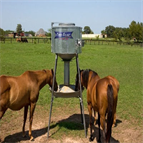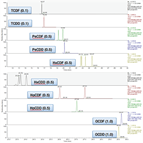Find methods for your needs
Refine by Feature
Displaying 1-4 of 4 results for Tag: Feed
Analysis of Melamine and Cyanuric Acid in Food Matrices by LC-MS/MS
Instrument Type: LCMSMSIn March 2007, several North American manufacturers of pet food voluntarily issued nationwide recall notices for some of their products that were reportedly associated with renal failure in pets. It was discovered that melamine-contaminated China-sourced ingredients had been used to prepare feed for chickens, swine, and catfish. Consequently, the FDA and the USDA have developed methods for the analysis of melamine residues in animal tissue. Both methods use tandem MS detection and employ disposable strong cation exchange SPE cartridges to prepare samples for liquid chromatographic analysis.
Increasing Speed of UHPLC-MS Analysis Using Single-stage Orbitrap Mass Spectrometer
Instrument Type: LCMSProductivity of an LC-MS system is measured in samples per day. Modern ultrahigh pressure LC-MS (UHPLC-MS) methods increasingly deal with very short gradients, leading to chromatographic signals with peak widths below 5 seconds at the base. It is still a challenge for high-resolution, accurate mass (HR/AM) systems to provide a sufficient number of scans (=10) across the chromatographic peak in full scan mode without compromising sensitivity and selectivity. We describe a system that addresses these challenges.
Qualitative and Quantitative Analysis of Pesticides in Horse Feed Matrix Using Orbitrap MS
Instrument Type: LCMSMSIn this work, the Exactive Plus instrument was used to analyze extracts of horse feed spiked with common pesticides. We demonstrate the ability of a high-resolution, accurate-mass benchtop mass spectrometer to achieve high sensitivity and selectivity when analyzing modern, very-short-gradient UPHLC separations of complex samples.
Meeting the Upcoming European Commission Performance Criteria for the Use of Triple Quadrupole GC-MS/MS as a Confirmatory Method for PCDD/Fs in Food and Feed Samples
Instrument Type: GCMSMSPolychlorinated dibenzo-p-dioxins (PCDDs) and polychlorinated dibenzofurans (PCDFs) constitute a group of highly toxic organic compounds. PCDD/Fs have been characterized by the US Environmental Protection Agency as likely to be carcinogenic to humans. Recent technological advances in GC-MS/MS technology led to GC-MS/MS being considered a reliable tool that can be used to control the maximum levels for PCDD/Fs in food and feed. In this work, the performance of the Thermo Scientific TSQ 8000 Evo triple quadrupole GC-MS/MS for the analysis of PCDD/Fs was assessed.




